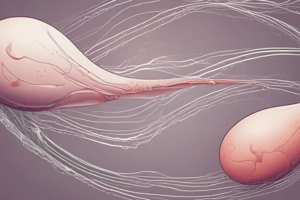Podcast
Questions and Answers
Which hormone is responsible for the differentiation of male internal and external genitalia during development?
Which hormone is responsible for the differentiation of male internal and external genitalia during development?
- Follicle-stimulating hormone (FSH)
- Luteinizing hormone (LH)
- Mullerian-inhibiting substance (MIS)
- Testosterone (correct)
What determines gonadal sex in humans?
What determines gonadal sex in humans?
- The presence or absence of the SRY gene on the X chromosome
- The presence of ovaries in females and testes in males
- The presence of the uterus in females and the prostate in males
- The presence or absence of the SRY gene on the Y chromosome (correct)
What is the frequency of oocyte production in females?
What is the frequency of oocyte production in females?
- A single oocyte approximately once a day
- A single oocyte approximately once a month (correct)
- A single oocyte approximately once a week
- Millions of oocytes continuously
Flashcards are hidden until you start studying
Study Notes
Human Reproductive Physiology and Sexual Differentiation
- Human reproduction involves both procreation and pleasure, and is characterized by physiological and psychological satisfaction.
- Males produce millions of spermatozoa continuously, while females produce a single oocyte approximately once a month.
- Fertilization occurs when a sperm enters the female reproductive tract and fertilizes the oocyte. The developing embryo implants in the uterus and the placenta develops.
- The female breast differentiates during pregnancy to allow lactation and breastfeeding.
- The pituitary, gonadal, and placental hormones orchestrate the complex events in male and female reproductive physiology.
- Sexual differentiation occurs in utero, but final maturation is completed during puberty.
- Sex determination involves genetic, gonadal, and phenotypic processes.
- Genetic sex is determined by the sex chromosomes, with males having XY and females having XX.
- Gonadal sex is determined by the presence of testes in males and ovaries in females.
- Phenotypic sex is determined by the characteristics of the internal and external genitalia.
- The presence or absence of the SRY gene on the Y chromosome determines gonadal differentiation.
- Testosterone and Müllerian-inhibiting substance (MIS) secreted by the testes cause differentiation of male internal and external genitalia, while the absence of these hormones leads to the development of female genitalia.
Studying That Suits You
Use AI to generate personalized quizzes and flashcards to suit your learning preferences.



